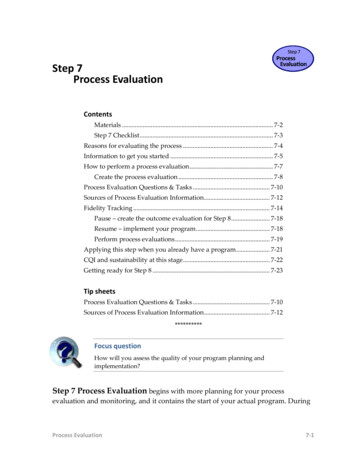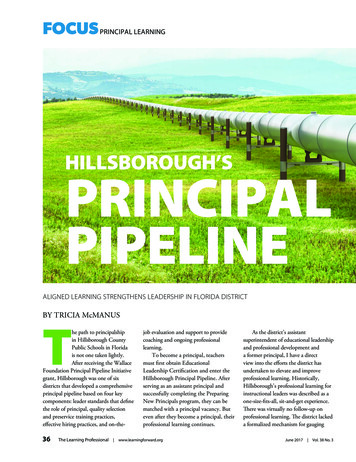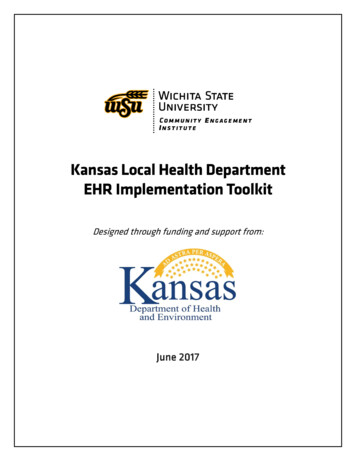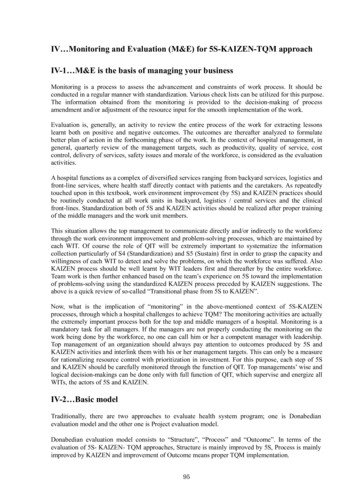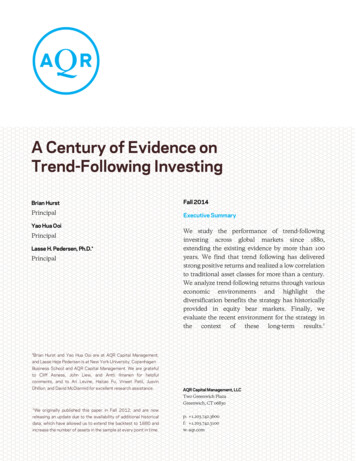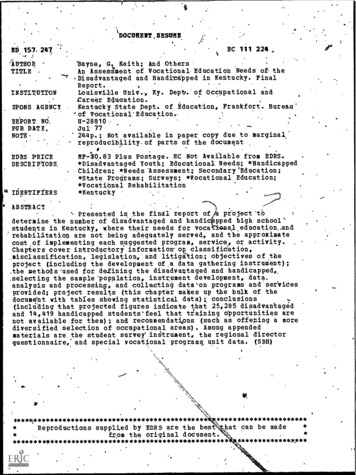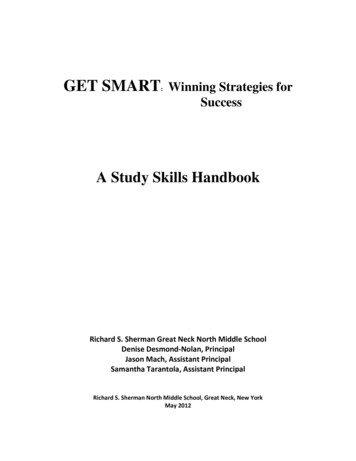
Transcription
North Carolina School Executive:PRINCIPAL ANDASSISTANT PRINCIPALE VALUATION PR OCESSPublic Schools of North CarolinaState Board of EducationDepartment of Public Instruction 20200909 McRELMcRMcRELEL DeDeveDevelopedvelolopeped in collaborationccolollalaboboraratitionon withwitithwh thethe NC StateSBoard of Education Revised September 2012 DeveDeDevelopedvelolopepedd inwithwith thethe NC StateStaStatete BoardBoarBoard of Education.arSeptember 2, 2010.1
STATE BOARD OF EDUCATIONThe guiding mission of the North Carolina State Board of Education is that every public school student will graduatefrom high school, globally competitive for work and postsecondary education and prepared for life in the 21st Century.WILLIAM C. HARRISONChairman :: FayettevilleREGINALD KENANRose HillJOHN A. TATE IIICharlotteWAYNE MCDEVITTVice Chair :: AshevilleKEVIN D. HOWELLRaleighROBERT “TOM”SPEEDBooneWALTER DALTONLieutenant Governor ::RutherfordtonSHIRLEY E.HARRISTroyJANET COWELLState Treasurer :: RaleighCHRISTINE J.GREENEHigh PointJEAN W. WOOLARDPlymouthMELISSA E.BARTLETTRoxboroPATRICIA N.WILLOUGHBYRaleighNC DEPARTMENT OF PUBLIC INSTRUCTIONJune St. Clair Atkinson, Ed.D., State Superintendent301 N. Wilmington Street :: Raleigh, North Carolina 27601-2825In compliance with federal law, NC Public Schools administers all state-operated educational programs, employment activities andadmissions without discrimination because of race, religion, national or ethnic origin, color, age, military service, disability, or gender, exceptwhere exemption is appropriate and allowed by law.Inquiries or complaints regarding discrimination issues should be directed to:Dr. Rebecca Garland, Chief Academic Officer :: Academic Services and Instructional Support6368 Mail Service Center, Raleigh, NC 27699-6368 :: Telephone: (919) 807-3200 :: Fax: (919) 807-4065For information regarding Educator Recruitment and Development please contact:Lynne Johnson, Director :: Educator Recruitment and Development6330 Mail Service Center, Raleigh, NC 27699-6330 :: Telephone: (919) 807-3355 :: Fax: (919) 807-3362Visit us on the Web :: www.ncpublicschools.org
Future-Ready Students: Goals for the 21st CenturyThe guiding mission of the North Carolina State Board of Education is that every public school student willgraduate from high school, globally competitive for work and postsecondary education and prepared forlife in the 21st century.NC Public Schools Will Produce GloballyCompetitive Students. Every student excels in rigorous and relevant core curriculumthat reflects what students need to know and demonstrate in aglobal 21st Century environment, including a mastery oflanguages, an appreciation of the arts and competencies in theuse of technology. Every student’s achievement is measured with anassessment system that informs instruction and evaluatesknowledge, skills, performance and dispositions needed inthe 21st Century. Every student will be enrolled in a course of study designedto prepare them to stay ahead of international competition. Every student uses technology to access and demonstratenew knowledge and skills that will be needed as a life-longlearner to be competitive in a constantly changinginternational environment. Every student has the opportunity to graduate from highschool with an Associate’s Degree or college transfer credit.NC Public Schools Will Be Led By 21st CenturyProfessionals. Every teacher will have the skills to deliver 21st Centurycontent in a 21st Century context with 21st Century tools andtechnology that guarantees student learning. Every teacher and administrator will use a 21st Centuryassessment system to inform instruction and measure 21stCentury knowledge, skills, performance and dispositions. Every education professional will receive preparation in theinterconnectedness of the world with knowledge and skills,including language study. Every education professional will have 21st Centurypreparation and access to ongoing, high quality professionaldevelopment aligned with State Board of Educationpriorities. Every educational professional uses data to inform decisions.NC Public School Students Will Be Healthy andResponsible. Every learning environment will be inviting, respectful, supportive, inclusive and flexible for student success.Every school provides an environment in which each childhas positive, nurturing relationships with caring adults.Every school promotes a healthy, active lifestyle wherestudents are encouraged to make responsible choices.Every school focuses on developing strong student character,personal responsibility and community/world involvement.Every school reflects a culture of learning that empowersand prepares students to be life-long learners.Leadership Will Guide Innovation in NC Public Schools. School professionals will collaborate with national andinternational partners to discover innovative transformationalstrategies that will facilitate change, remove barriers for21st Century learning and understand global connections. School leaders will create a culture that embraces changeand promotes dynamic, continuous improvement. Educational professionals will make decisions incollaboration with parents, students, businesses, educationinstitutions, and faith-based and other community and civicorganizations to impact student success. Public school professionals will collaborate withcommunity colleges and public and private universities andcolleges to provide enhanced educational opportunities forstudents.NC Public Schools Will Be Governed and Supported By21st Century Systems. Processes are in place for financial planning and budgetingthat focus on resource attainment and alignment withpriorities to maximize student achievement. Twenty-first century technology and learning tools areavailable and are supported by school facilities that have thecapacity for 21st Century learning. Information and fiscal accountability systems are capable ofcollecting relevant data and reporting strategic andoperational results. Procedures are in place to support and sanction schools thatare not meeting state standards for student achievement.
North Carolina School Executive Principal Evaluation ProcessNorth Carolina School Executive:Principal and Assistant Principal Evaluation ProcessIntroductionPurposes of the EvaluationDefinitionsPrincipal/Assistant Principal and Evaluator ResponsibilitiesInstructions for Principal and Assistant Principal Evaluation Process55578North Carolina Standards for School ExecutivesA New Vision of School LeadershipPhilosophical Foundation for the School Executive StandardsIntended Purposes of the StandardsOrganization of the StandardsThe Eight Standards of Executive Leadership and Their ConnectionsThe Standards and Their PracticesCompetencies1010101011111118Framework for 21st Century Learning20Milestones for Improving Learning and Education22Rubric for Evaluating North Carolina Principals/Assistant PrincipalsExplanation of the Rubric and Performance RatingsRubric for Evaluation and Self-Assessment (Required)Directions for Completing the RubricCompleting the Rubric for Self-AssessmentCompleting the Rubric and Summary/End-of-Year Evaluation Rating From for EvaluationExample of How to Complete the Rubric and Summary Evaluation Worksheet242425373738End-of-Year Evaluation FormsPrincipal/Assistant Principal Summary/End-of-Year Evaluation Rating Form (Required)Summary Evaluation Worksheet4250Appendix A: Optional Evaluation FormsGoal Setting WorksheetNorth Carolina Principal/Assistant Principal Goal Development FormMid-Year Evaluation: Progress Toward Achieving GoalsPrincipal/Assistant Principal Evaluation Process Documentation52535455Appendix B: Code of Ethics for North Carolina Educators56 2009 McREL Developed in collaboration with the NC State Board of Education Revised September 20124
North Carolina School Executive Principal Evaluation ProcessIntroductionThe mission of the North Carolina State Board of Education is that every public school student will graduate from high school,globally competitive for work and postsecondary education and prepared for life in the 21st century. This mission requires a new visionof school leadership and dictates the need for a new type of school leader—an executive instead of an administrator. No longer areschool leaders just maintaining the status quo by managing complex operations. Like their colleagues in business, they must be able tocreate schools as organizations that can learn and change quickly if they are to improve performance. Schools need principals andassistant principals who are adept at creating systems for change and building relationships with and across staff. These systems notonly tap into the collective knowledge and insight they possess but also into the powerful relationships that stir their passions for theirwork with children. Out of these relationships principals and assistant principals must create among staff a shared understanding forthe purpose of the work of the school, its values that direct its action and commitment and ownership of a set of beliefs and goals thatfocus everyone’s decision making. This common understanding of the school’s identity empowers them to seek and build powerfulalliances and partnerships with students, parents and community stakeholders in order to enhance their ability to produce increasedstudent achievement. The successful work of the new principal or assistant principal will only be realized in the creation of a culture inwhich leadership:§ Is distributed among all members of the school community;§ Consists of open, honest communication;§ Is focused on the use of data, teamwork, researched-based practices; and§ Uses tools to drive ethical and principled, goal-oriented action.This culture of disciplined thought and action is rooted in the ability of the relationships among stakeholders to build a trusting,transparent environment that reduces stakeholders’ sense of vulnerability as they address the challenges of transformationalchange.The Purposes of the EvaluationThe principal/assistant principal performance evaluation process will:§ Serve as a guide for principals/assistant principals as they reflect upon and improve their effectiveness as schoolleaders;§ Inform higher education programs in developing the content and requirements of degree programs that preparefuture principals/assistant principals;§ Focus the goals and objectives of districts as they support, monitor and evaluate their principals/assistant principals;§ Guide professional development for principals/assistant principals; and§ Serve as a tool in developing coaching and mentoring programs for principals/assistant principals.DefinitionsFor purposes of this evaluation process, the following terms are defined below:1. Artifact – A product resulting from a principal’s/assistant principal’s work. Artifacts are natural by-products of work andare not created for the purpose of satisfying evaluation requirements. Artifacts are used as evidence to support anevaluation rating and when the evaluator and the principal or assistant principal disagree on the final rating.Principals/assistant principals may use them as exemplars of their work.Examples of artifacts include these:§ School Improvement Plan – A plan that includes strategies for improving student performance, how and whenimprovements will be implemented, use of state funds, requests for waivers, etc. Plans are in effect for no morethan three years.§ School Improvement Team Data – Work from a team made up of the school executive and representatives ofadministration, instructional personnel, instructional support personnel, teacher assistants and parents ofchildren enrolled in the school whose purpose is to develop a school improvement plan to strengthen studentperformance. 2009 McREL Developed in collaboration with the NC State Board of Education Revised September 20125
North Carolina School Executive Principal Evaluation Process§2.3.4.5.6.7.8.9.North Carolina Teacher Working Conditions Survey – A statewide survey of teacher working conditions in fiveareas—time, empowerment, facilities and resources, leadership and professional development—conducted on abiennial basis (see www.ncteachingconditions.org).§ Student Achievement Data – Student achievement/testing data available from the North Carolina SchoolReport Card. (See www.ncschoolreportcard.org).§ Student Dropout Data – Data about grade 9–12 students who drop out of high school. (Seewww.ncschoolreportcard.org).§ Teacher Retention Data – The teacher turnover rate, including the distribution of inexperienced teachers.§ National Board Certified Teachers – Teachers who have earned National Board Certification.§ Professional Development – Staff development, based on research, data, practice and reflection that focuses ondeepening knowledge and pedagogical skills in a collegial and collaborative environment.§ PTSA Data– Work or related documents of the school’s parent, teacher, student association.Code of Ethics for North Carolina Educators – The standards of professional conduct required of educators. (See AppendixB, p.56).Code of Professional Practice and Conduct for North Carolina Educators – The uniform standards of professional conduct forlicensed professional educators. (See Appendix B, p.57).Data – Factual information used as the basis for reasoning, discussion or planning.Evidence – Documents that demonstrate or confirm the work of the person being evaluated and support the rating on agiven element.North Carolina School Executive Evaluation Rubric – A composite matrix of the standards, elements and descriptors of theNorth Carolina Standards for School Administrators§ Performance Standard – The distinct aspect of leadership or realm of activities which form the basis for theevaluation of a school executive.§ Performance Elements – The sub-categories of performance embedded within the performance standard.§ Performance Descriptors – The specific performance responsibilities embedded within the elements of eachperformance standard. Descriptors are checked to determine the rating of each element.Optional Evaluation Forms – Forms that will help principals, assistant principals, and evaluators gain a deeperunderstanding of the principal’s/assistant principal’s level of performance. These forms are not required by the NCDepartment of Public Instruction. (See Appendix A, p.52).§ Goal Setting Worksheet-to identify strengths and areas for improvement§ North Carolina Principal/Assistant Principal: Summary Goal Form§ Mid-Year Evaluation: Progress Toward Achieving Goals§ Principal/Assistant Principal Evaluation Process DocumentationPerformance Goals – Goals for improvement in professional practice based on the self-assessment and/or supervisorrecommendation.Performance Rating Scales- (There are different rating scales for standards 1-7 and standard 8.)Performance Rating Scale For Standards 1-7– The following rating scale will be used for evaluating North Carolinaschool principals and assistant principals for standards 1-7:§ Developing: Principal/assistant principal demonstrated adequate growth toward achieving standard(s) duringthe period of performance, but did not demonstrate competence on standard(s) of performance.§ Proficient: Principal/assistant principal demonstrated basic competence on standard(s) of performance§ Accomplished: Principal/assistant principal exceeded basic competence on standard(s) for performance mostof the time.§ Distinguished: Principal/assistant principal consistently and significantly exceeded basic competence onstandards of performance.§ Not Demonstrated: Principal/assistant principal did not demonstrate competence on or adequate growthtoward achieving standard(s) of performance. If the “Not Demonstrated” rating is used, the evaluator mustcomment about why it was used. 2009 McREL Developed in collaboration with the NC State Board of Education Revised September 20126
North Carolina School Executive Principal Evaluation Process10.11.12.13.Performance Rating For Standard 8: An executive’s rating on the eighth standard is determined by a school-wide growth value ascalculated by the statewide growth model for educator effectiveness. The student growth value places an executive into one of three ratingcategories:§ Does not meet expected growth: The school-wide student growth value is lower than what was expected perthe statewide growth model.§ Meets expected growth: The school-wide student growth value is what was expected per the statewidegrowth model.§ Exceeds expected growth: The school-wide student growth value exceeds what was expected per thestatewide growth model.School Executives – Principals/assistant principals licensed to work in North Carolina.Self-assessment – Personal reflection about one’s professional practice to identify strengths and areas for improvementconducted without input from others.Status – An overall status for a school executive is determined once the executive has a three-year rolling average ofschool-wide student growth values to populate Standard 8. There are three categories for status:§ In Need of Improvement. An administrator who fails to receive a rating of at least “proficient” on each of theEvaluation Standards 1-7 or receives a rating of “does not meet expected growth on Standard 8.§ Effective. An administrator who receives a rating of at least “proficient” on each of the Evaluation Standards1-7 and receives a rating of at least “meets expected growth” on Standard 8.§ Highly Effective. An administrator who receives a rating of at least “accomplished” on each of theEvaluation Standards 1-7 and receives a rating of “exceeds expected growth” on Standard 8.Summary/End-of-Year Evaluation: A composite of the principal’s/assistant principal’s performance based on theevaluation rubric and supporting evidence.Principal/Assistant Principal and Evaluator ResponsibilitiesPrincipal/Assistant Principal Responsibilities:§ Know and understand the North Carolina Standards for School Executives.§ Understand the North Carolina School Executive: Principal and Assistant Principal Evaluation Process.§ Prepare for the initial meeting, including a self-evaluation, identification of performance goals, and identification ofchange initiatives underway at their school.§ Gather data, artifacts, evidence to support performance in relation to standards and progress in attaining goals.§ Develop and implement strategies to improve personal performance/attain goals in areas individually or collaborativelyidentified.§ Participate in the Mid-year and Final Evaluation Conferences.Evaluator Responsibilities:§ Know and understand the North Carolina Standards for School Executives§ Participate in training to understand and implement the North Carolina School Executive: Principal and AssistantPrincipal Evaluation Process.§ Supervise the North Carolina School Executive: Principal and Assistant Principal Evaluation Process and ensure that allsteps are conducted according to the approved process.§ Identify the principal’s/assistant principal’s strengths and areas for improvement and make recommendations forimproving performance.§ Ensure that the contents of the Principal/Assistant Principal Evaluation Rating Form contains accurate information andaccurately reflects the principal’s/assistant principal’s performance. 2009 McREL Developed in collaboration with the NC State Board of Education Revised September 20127
North Carolina School Executive Principal Evaluation ProcessInstructions for North Carolina School Executive:Principal and Assistant Principal Evaluation ProcessThe intended purpose of the evaluation process is to assess the principal’s or assistant principal’s performance in relationto the North Carolina Standards for School Executives in a collegial and non -threatening manner. The individual beingevaluated will take the lead in conducting the evaluation process through the use of self -assessment, reflection and bygathering input from the various stakeholders with an interest in the leadership in the school. The input and evidencegathered by the principal or assistant principal is not intended to become part of a portfolio. Rather, it should provide abasis for self-assessment, goal-setting, professional development, and demonstration of performance on specificstandards. The following steps outline the required elements of the evaluation process.Step 1: OrientationAt the beginning of the school year, the superintendent/designee will conduct a group orientation with all of the district principalsand assistant principals. At this orientation, each principal and assistant principal will be provided a complete set of materialsoutlining the evaluation process.Step 2: Pre-Evaluation Planning/Preparation for Initial MeetingPrincipals and assistant principals will complete a self-assessment using the Rubric for Evaluating North CarolinaPrincipals/Assistant Principals. (pp. 25-36) This self-assessment will serve as the basis for goal development, which should becompleted prior to Step 3.Step 3: Initial Meeting Between Principal/Assistant Principal and Superintendent/DesigneePrincipals/assistant principals will meet individually with the district superintendent/designee who has been delegated theresponsibility to discuss the results of the self-evaluation, goal development, and the evidence and data to be gathered for theevaluation process. The principal/assistant principal and superintendent/designee will agree on the data, evidence, and artifactsnecessary to complete the evaluation process and confirm the principal’s/assistant principal’s level of performance.Step 4: Data CollectionThe principal/assistant principal will collect the data agreed upon in Step 3. These data may include the artifacts listed for eachstandard on the rubric; feedback from parents, students, and the school community; documentation of professional developmentcompleted during the year; and other data to document achievement of performance goals. The district superintendent/designeewill visit the school during this period in order to observe the environment and interact with teachers and other members of theschool community.Step 5: Mid-Year Evaluation Between Principal/Assistant Principal and Superintendent/DesigneePrincipals/assistant principals will meet individually with the district superintendent or a designee who has been delegated theresponsibility to discuss the principal’s/assistant principal’s progress toward achieving his or her annual goals. This mid-yeardiscussion will focus on the status of goal attainment and mid-year adjustments to action plans that must be made in order toachieve goals by the end of the school year. By mid-year, school-wide student growth data should be available for review.Step 6: Prepare a Consolidated Performance AssessmentThe principal/assistant principal will synthesize the information obtained under Steps 4 and 5 in order to prepare a consolidatedassessment or comprehensive view of performance throughout the year. This brief summary of the data and artifacts used tojudge performance should be provided to the superintendent/designee well in advance of the performance discussion at whichfinal performance levels will be discussed. 2009 McREL Developed in collaboration with the NC State Board of Education Revised September 20128
North Carolina School Executive Principal Evaluation ProcessStep 7: Meeting Between Principal/Assistant Principal and Superintendent/DesigneeThe principal/assistant principal and superintendent/designee will meet at the school to discuss progress in completing theevaluation process. They will discuss the self-assessment, consolidated assessment, and summary/end-of-year evaluation of theprincipal/assistant principal, which the superintendent/designee prepared in advance of the meeting. Should additional data orartifacts need to be brought into the discussion; the principal/assistant principal will have them readily available to share at thattime. At this meeting, the principal/assistant principal and superintendent/designee will agree upon the next year’s performancegoals.All forms needed to complete this process are included in this packet. While all of the forms are highly recommended, use of thefollowing is required:§ Rubric for Evaluating North Carolina Principals/Assistant Principals and Self-Assessment Form (pp. 25-36).§ Principal/Assistant Principal Summary/End-of-Year Evaluation Rating Form ( pp. 42-47) 2009 McREL Developed in collaboration with the NC State Board of Education Revised September 20129
North Carolina School Executive Principal Evaluation ProcessNorth Carolina Standards For School ExecutivesA New Vision of School LeadershipPublic education’s changed mission dictates the need for a new type of school leader — an executive instead of an administrator.No longer are school leaders just maintaining the status quo by managing complex operations but just like their colleagues inbusiness, they must be able to create schools as organizations that can learn and change quickly if they are to improveperformance. Schools need executives who are adept at creating systems for change and at building relationships with and acrossstaff that not only tap into the collective knowledge and insight they possess but powerful relationships that also stir theirpassions for their work with children. Out of these relationships the executive must create among staff a common sharedunderstanding for the purpose of the work of the school, its values that direct its action, and commitment and ownership of a setof beliefs and goals that focus everyone’s decision making. The staff ’s common understanding of the school’s identity empowersthem to seek and build powerful alliances and partnerships with students, parents and community stakeholders in order toenhance their ability to produce increased student achievement. The successful work of the new executive will only be realized inthe creation of a culture in which leadership is distributed and encouraged with teachers, which consists of open, honestcommunication, which is focused on the use of data, teamwork, research-based best practices, and which uses modern tools todrive ethical and principled, goal-oriented action. This culture of disciplined thought and action is rooted in the ability of therelationships among all stakeholders to build a trusting, transparent environment that reduces all stakeholders’ sense ofvulnerability as they address the challenges of transformational change.Philosophical Foundation for the School Executive StandardsThe standards are predicated on the following beliefs:§ Today, schools must have proactive school executives who possess a great sense of urgency.§ The goal of school leadership is to transform schools so that large-scale, sustainable, continuous improvementbecomes built in to their mode of operation.§ The moral purpose of school leadership is to create schools in which all students learn, the gap between high andlow performance is greatly diminished and what students learn will prepare them for success in their futures, notours.§ Leadership is not a position or a person. It is a practice that must be embedded in all job roles at all levels of theschool district.§ The work of leadership is about working with, for and through people. It is a social act. Whether we are discussinginstructional leadership, change leadership or leadership as learning, people are always the medium for the leader.§ Leadership is not about doing everything oneself but it is always about creating processes and systems that willcause everything to happen.§ Leadership is about the executive’s ability to select and develop a strong executive staff whose complementarystrengths promote excellence in all seven functions of leadership identified in this document.§ The concept of leadership is extremely complex and systemic in nature. Isolating the parts of leadership completelymisses the power of the whole. It is not just knowing what to do, but why to do it, how to do it and when to do it.§ Within a school district there are nested leadership systems (local boards of education, central office, school, andclassroom). For the organization to be successful these systems must be aligned and supportive, and function as ateam.§ Leadership is about setting direction, aligning and motivating people to implement positive sustained improvement.§ Leaders bring their “person” to the practice of leadership. Matching the context of leadership to the “person” of theindividual is important to the success of the leader.Intended Purposes of the StandardsThe North Carolina School Executive Standards have been developed as a guide for principals and assistant principals as theycontinually reflect upon and improve their effectiveness as leaders throughout all of the stages of their careers. Although there aremany influences on a school executive’s development, these standards will serve as an important tool for principals and assistantprincipals as they consider their growth and development as executives leading schools in the 21st century. Taken as a whole thesestandards, practices and competencies are overwhelming. One might ask, “How can one person possess all of these?” The answer 2009 McREL Developed in collaboration with the NC State Board of Education Revised September 201210
North Carolina School Executive Principal Evaluation Processis they cannot. It is, therefore, imperative that a school executive understands the importance of building an executive team thathas complementary skills. The more diversity that exists on the team the more likely the team will be to demonstrate highperformance in all critical function areas. The main responsibility of the school executive is to create aligned systems of leadershipthroughout the school and its community.In addition, these standards will serve other audiences and purposes. Th
Principal/Assistant Principal Summary/End-of-Year Evaluation Rating Form (Required) 42 Summary Evaluation Worksheet 50 Appendix A: Optional Evaluation Forms Goal Setting Worksheet 52 North Carolina Principal/Assistant Principal Goal Development Form 53 Mid-Year Evaluation: Progress Toward Achieving Goals 54

